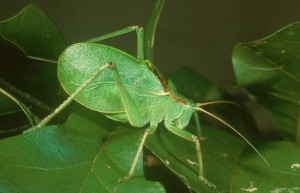This leaf is not really a leaf at all. You are actually seeing an insect: a katydid (Orthoptera: Tettigoniidae) (Figure 1). On closer inspection, what you may have referred to as a grasshopper is, in fact, related to grasshoppers but is not one itself. Similar to grasshoppers, katydids can jump long distances due to their enlarged hind femurs, and these same hind legs can produce sound. Unlike most grasshoppers though, katydids possess long, thin antennae as long as their body, though sometimes longer, and, as you have noticed, many species highly resemble leaves.
Figure 1. A true katydid, Paracyrtophyllus robustus, standing on a leaf. Notice the intricate pattern resembling leaf venation on the wings. Photograph by Tom Walker, University of Florida.
So what exactly are those leafy structures on the katydid? No, the katydid does not carry leaves on its back. Those are its wings. Each leaf is a forewing that covers the hindwings. By appearing as a leaf, the katydid camouflages into its surroundings, avoiding predators like hungry birds. Many katydids also have a green head and abdomen to give it better chances of blending in. It is important to note that not all katydids look this way. Some species are found in yellow, pink, orange, brown, and tan. And what’s more, the immature nymphs and some adult species are wingless.
This guest post authored by Shari Linn, Fall 2015 Entomology Intern.
 1
1

